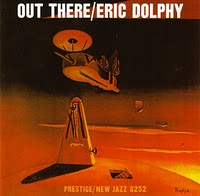 At first Out There sounds like an Ornette Coleman album, but then you realize that Eric Dolphy has twisted Coleman’s weird ideas around his even stranger finger. I mean…legendary bassist Ron Carter plays cello. Cello!!! George Duvivier plays bass. What a stroke of genius. There’s less musicians on Out There than on Dolphy masterpiece Out To Lunch. In fact, Dolphy is the only horn period. He puts in mind blowing solos on alto sax, flute, b-flat clarinet and bass clarinet. If I had to choose the most talented reed and woodwind player of all time it would be a tie between Eric Dolphy and Rahsaan Roland Kirk. While Kirk absolutely mastered more than 50 instruments, Dolphy can make a clarinet sound drop-dead sexy one moment and convince you that the world is ending the next. The same goes for any instrument that he played. “Sketch of Melba” has some stunning flute playing. –Rob
At first Out There sounds like an Ornette Coleman album, but then you realize that Eric Dolphy has twisted Coleman’s weird ideas around his even stranger finger. I mean…legendary bassist Ron Carter plays cello. Cello!!! George Duvivier plays bass. What a stroke of genius. There’s less musicians on Out There than on Dolphy masterpiece Out To Lunch. In fact, Dolphy is the only horn period. He puts in mind blowing solos on alto sax, flute, b-flat clarinet and bass clarinet. If I had to choose the most talented reed and woodwind player of all time it would be a tie between Eric Dolphy and Rahsaan Roland Kirk. While Kirk absolutely mastered more than 50 instruments, Dolphy can make a clarinet sound drop-dead sexy one moment and convince you that the world is ending the next. The same goes for any instrument that he played. “Sketch of Melba” has some stunning flute playing. –Rob
Album Reviews
Rush “Hemispheres” (1978)
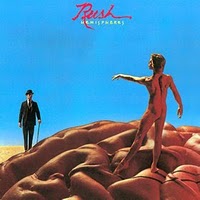 Hemispheres is the culmination of all that Rush had been striving for since Neil Peart ascended to the drum stool back on Fly By Night. The side-long title track is a winding conceptual piece that one-ups 2112 in it’s uniformity and metaphorical marriage of paperback fantasy with egghead philosophy. A continuation of A Farewell To Kings’ “Cygnus X-1” (on tour Rush would play both pieces together, forming one 30-minute monstrosity), “Hemispheres” tells a convoluted tale of the “battle of heart and mind” that dabbles in Greek mythology and Nietzsche-inspired psychology, set to an ever-unfolding barrage of head-spinning riffs. But it’s side two of Hemispheres that ensures it’s classic status, with the brief, but hard-hitting and lyrically direct “Circumstances,” ably leading things off. “The Trees,” an almost Brothers Grimm styled allegorical tale of the pitfalls of collectivism, quickly became a Rush standard, as did the multi-part instrumental “La Villa Strangiato.” Subtitled with a wink, “An Exercise in Self-Indulgence,” the showcase is a tour-de-force of prog-rock muscle that probably inspired half of the kids who heard it to hone their musical chops, while the other half headed straight for the record store’s newly-added punk bin. But in it’s own way, Hemispheres is as uncompromising a statement as any, and with it Rush carved a permanent niche as leaders of their own pencil-necked revolution. –Ben
Hemispheres is the culmination of all that Rush had been striving for since Neil Peart ascended to the drum stool back on Fly By Night. The side-long title track is a winding conceptual piece that one-ups 2112 in it’s uniformity and metaphorical marriage of paperback fantasy with egghead philosophy. A continuation of A Farewell To Kings’ “Cygnus X-1” (on tour Rush would play both pieces together, forming one 30-minute monstrosity), “Hemispheres” tells a convoluted tale of the “battle of heart and mind” that dabbles in Greek mythology and Nietzsche-inspired psychology, set to an ever-unfolding barrage of head-spinning riffs. But it’s side two of Hemispheres that ensures it’s classic status, with the brief, but hard-hitting and lyrically direct “Circumstances,” ably leading things off. “The Trees,” an almost Brothers Grimm styled allegorical tale of the pitfalls of collectivism, quickly became a Rush standard, as did the multi-part instrumental “La Villa Strangiato.” Subtitled with a wink, “An Exercise in Self-Indulgence,” the showcase is a tour-de-force of prog-rock muscle that probably inspired half of the kids who heard it to hone their musical chops, while the other half headed straight for the record store’s newly-added punk bin. But in it’s own way, Hemispheres is as uncompromising a statement as any, and with it Rush carved a permanent niche as leaders of their own pencil-necked revolution. –Ben
T. Rex “Zinc Alloy and the Hidden Riders of Tomorrow” (1974)
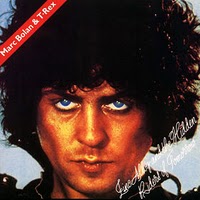 Conventional wisdom holds that Marc Bolan & T. Rex started to sink with Zinc Alloy and the Hidden Riders of Tomorrow (or was it Tanx?) into his bloated period of mid-seventies mediocrity, but as a Bolan apologist I still hold it in high regard. Certainly, Zinc Alloy is the strangest release yet from the glitter-rock fairy, an often uncomfortable and chaotic collection that radiates a nasty, coke-fueled jitter. Bolan’s idea of the new T-Rex sound was some sort of bubblegum-soul hybrid, and to that end he introduced future Mrs. Bolan, Gloria Jones, to the T-Rex fold, whose blood-curdling wail ironically possessed about as much soul as a set of fingernails being drawn across a chalkboard. Her voice, plus heavy doses of Bolan’s spazzy fuzz guitar, and strings and synthesizers, are some of the odd limbs comprising this stumbling, glam-funk Frankenstein. But Bolan could pull killer hooks out of his wizard’s hat no matter how deluded his vision had become in his quest to break the American market, witness the jumpy “Venus Loon,” jubilant “Interstellar Soul” and “Nameless Wilderness” or glam grind of “Liquid Gang.” Elsewhere, song fragments like “Galaxy” and “Spanish Midnight” house equally effective melodies, while the sweaty “Explosive Mouth” and grand “Carlisle Smith & the Old One” are other lost gems from this release. The relatively tame “Teenage Dream,” with it’s retro-50’s lean, would make for an odd single flop from the album. –Ben
Conventional wisdom holds that Marc Bolan & T. Rex started to sink with Zinc Alloy and the Hidden Riders of Tomorrow (or was it Tanx?) into his bloated period of mid-seventies mediocrity, but as a Bolan apologist I still hold it in high regard. Certainly, Zinc Alloy is the strangest release yet from the glitter-rock fairy, an often uncomfortable and chaotic collection that radiates a nasty, coke-fueled jitter. Bolan’s idea of the new T-Rex sound was some sort of bubblegum-soul hybrid, and to that end he introduced future Mrs. Bolan, Gloria Jones, to the T-Rex fold, whose blood-curdling wail ironically possessed about as much soul as a set of fingernails being drawn across a chalkboard. Her voice, plus heavy doses of Bolan’s spazzy fuzz guitar, and strings and synthesizers, are some of the odd limbs comprising this stumbling, glam-funk Frankenstein. But Bolan could pull killer hooks out of his wizard’s hat no matter how deluded his vision had become in his quest to break the American market, witness the jumpy “Venus Loon,” jubilant “Interstellar Soul” and “Nameless Wilderness” or glam grind of “Liquid Gang.” Elsewhere, song fragments like “Galaxy” and “Spanish Midnight” house equally effective melodies, while the sweaty “Explosive Mouth” and grand “Carlisle Smith & the Old One” are other lost gems from this release. The relatively tame “Teenage Dream,” with it’s retro-50’s lean, would make for an odd single flop from the album. –Ben
Captain Beefheart “Shiny Beast (Bat Chain Puller)” (1978)
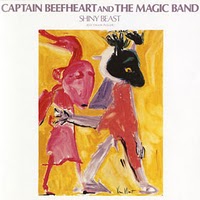 Captain Beefheart has always been sort of an enigma for me, an artist who I greatly respect and enjoy, but never quite fully understand where he is coming from. I finally got to the point where I put aside all my questioning and decided to just take in all the wacky bizarre features he incorporates. This notion proved to be the best way to listen to the Captain. Let’s face it – he’s weird, but he experiment’s with so many different things that you have to give him credit for being one of the most daring artists out there. I’ve come to be a big fan of all his music, but I still don’t know how to describe it. It’s similar to Frank Zappa, well, maybe not because I really can’t stand Frank’s music. I guess you could say it’s a cross between a free jazz freak out and an art-rock experiment. Whatever it is, it’s very interesting. And Shiny Beast is by far the most exciting album I have found of his. Every song is completely different from the next and it’s one of those rare albums where it never seems to get dull. If you are even remotely curious about the music of Captain Beefheart I would say begin here or with Trout Mask Replica; both are exceptional releases guaranteed to not disappoint. –Jason
Captain Beefheart has always been sort of an enigma for me, an artist who I greatly respect and enjoy, but never quite fully understand where he is coming from. I finally got to the point where I put aside all my questioning and decided to just take in all the wacky bizarre features he incorporates. This notion proved to be the best way to listen to the Captain. Let’s face it – he’s weird, but he experiment’s with so many different things that you have to give him credit for being one of the most daring artists out there. I’ve come to be a big fan of all his music, but I still don’t know how to describe it. It’s similar to Frank Zappa, well, maybe not because I really can’t stand Frank’s music. I guess you could say it’s a cross between a free jazz freak out and an art-rock experiment. Whatever it is, it’s very interesting. And Shiny Beast is by far the most exciting album I have found of his. Every song is completely different from the next and it’s one of those rare albums where it never seems to get dull. If you are even remotely curious about the music of Captain Beefheart I would say begin here or with Trout Mask Replica; both are exceptional releases guaranteed to not disappoint. –Jason
Soundtrack “Performance” (1970)
 Even if you haven’t seen the film — and heck, if you haven’t, why not? — this is a remarkably satisfying soundtrack album, put together by Jack Nitzsche and featuring Ry Cooder on guitar. (In places this sounds extremely close to Cooder’s own scores, such as for Paris, Texas.) Randy Newman sings “Gone Dead Train” in a much more urgent style than anything on his own early albums, while Mick Jagger’s version of “Memo from Turner” — with Cooder on guitar and members of Traffic — is a gloriously sleazy blues that should be in any Stones fan’s collection. (If you’ve only heard the Stones’ own fumbled version on Metamorphosis — according to legend, deliberately sabotaged by Keith as revenge for Mick screwing Anita Pallenberg on set — you really haven’t heard the song at all.) And how can you pass up a soundtrack that has the good sense to include the Last Poets’ “Wake Up Niggers”? (The first “rap” I’d ever heard.) –Brad
Even if you haven’t seen the film — and heck, if you haven’t, why not? — this is a remarkably satisfying soundtrack album, put together by Jack Nitzsche and featuring Ry Cooder on guitar. (In places this sounds extremely close to Cooder’s own scores, such as for Paris, Texas.) Randy Newman sings “Gone Dead Train” in a much more urgent style than anything on his own early albums, while Mick Jagger’s version of “Memo from Turner” — with Cooder on guitar and members of Traffic — is a gloriously sleazy blues that should be in any Stones fan’s collection. (If you’ve only heard the Stones’ own fumbled version on Metamorphosis — according to legend, deliberately sabotaged by Keith as revenge for Mick screwing Anita Pallenberg on set — you really haven’t heard the song at all.) And how can you pass up a soundtrack that has the good sense to include the Last Poets’ “Wake Up Niggers”? (The first “rap” I’d ever heard.) –Brad
X-Ray Spex “Germfree Adolescents” (1978)
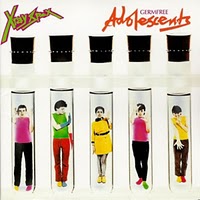 This is still one of most amazing, alluring and simply surreal records to emerge from punk rock — or simply rock. It’s a total one-off, and it hasn’t dated a bit. Where the hell did it come from? You can trace the lineage of the Clash or the Pistols back to their roots; Poly Styrene simply seems to have emerged completely formed, as if what she took from punk wasn’t a formula but a license to truly be herself. She is a wonderful lyricist, both critiquing and celebrating modern consumerism; for Poly, there’s something both fascinatingly alluring and horrifying in the plastic throwaway society. Really, the closest you’ll come to this record are J.G. Ballard’s 1970s novels such as Crash and The Unlimited Dream Company. The title track — about an obsessive-compulsive (as a result of rape?) — is one of the most haunting love songs you’ll ever hear. All this plus Styrene’s banshee wail and Rudi’s wild sax. So wonderfully alien — next to it, Bjork’s eccentricities looks like a tryhard wannabe. No wonder the band split after this; what was there left to say? –Brad
This is still one of most amazing, alluring and simply surreal records to emerge from punk rock — or simply rock. It’s a total one-off, and it hasn’t dated a bit. Where the hell did it come from? You can trace the lineage of the Clash or the Pistols back to their roots; Poly Styrene simply seems to have emerged completely formed, as if what she took from punk wasn’t a formula but a license to truly be herself. She is a wonderful lyricist, both critiquing and celebrating modern consumerism; for Poly, there’s something both fascinatingly alluring and horrifying in the plastic throwaway society. Really, the closest you’ll come to this record are J.G. Ballard’s 1970s novels such as Crash and The Unlimited Dream Company. The title track — about an obsessive-compulsive (as a result of rape?) — is one of the most haunting love songs you’ll ever hear. All this plus Styrene’s banshee wail and Rudi’s wild sax. So wonderfully alien — next to it, Bjork’s eccentricities looks like a tryhard wannabe. No wonder the band split after this; what was there left to say? –Brad
Humble Pie “Rock On” (1971)
 “Rock On” is Classic Rock with a Capitol C! It’s also The Pie’s very best record (in my Humble opinion). On this album a soulful Steve Marriott (of Small Faces) and guitar God Peter Frampton seamlessly blend all that was good about the seventies into one big sweaty orgy: hard rock, blues, country, gospel and R&B, all rolled up in glitter. Fans of Exile-era Stones, The Faces and Led Zeppelin will find something to love here. Throw this one on and watch the smiles on people’s faces as they groove to “Shine On,” “Sour Grain” and “Stone Cold Fever,” just three of many great tracks here. Criminally forgotten; shine some light back on “Rock On!” –David
“Rock On” is Classic Rock with a Capitol C! It’s also The Pie’s very best record (in my Humble opinion). On this album a soulful Steve Marriott (of Small Faces) and guitar God Peter Frampton seamlessly blend all that was good about the seventies into one big sweaty orgy: hard rock, blues, country, gospel and R&B, all rolled up in glitter. Fans of Exile-era Stones, The Faces and Led Zeppelin will find something to love here. Throw this one on and watch the smiles on people’s faces as they groove to “Shine On,” “Sour Grain” and “Stone Cold Fever,” just three of many great tracks here. Criminally forgotten; shine some light back on “Rock On!” –David
Jethro Tull “Songs From the Wood” (1977)
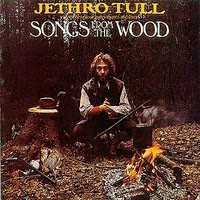 I love it! It’s a glorious celebration of folk traditions and lore. These are presented for our consumption on a richly musical platter. It opens shakily with the title track which starts off vocal-only. That part doesn’t work for me, but as soon as the music kicks in, I’m grabbed. As a song it certainly sets the scene and the tone for the album. “Jack-in-the-Green” is a vaguely amusing song about nature’s relationship with the seasons and the changing planet. “Cup of Wonder” seems to be an upbeat celebration of May Day (and of life?), while “Hunting Girl” is a weird tale of social and sexual impropriety. It seems a little out of place. “Ring Out, Solstice Bells” is a joyous celebration of the winter solstice. It should not be confused with what are generally known as Christmas songs. This is a purely pagan affair. “Velvet Green” brings together nature, sex and love themes very successfully. Very interesting; very earthy; very folky. “The Whistler” is OK. It just reminds me (musically) of something that Cat Stevens did before. “Pibroch (Cap in Hand)” is the longest, darkest and heaviest track on the album. It’s pretty good, featuring some folky instrumental passages, but these don’t all work as well as each other. “Fire at Midnight” is a touching little love song that closes the album. I really like the theme of the album. I think it works very well and the songs have been put together well. There is some great music too. It sounds very rich: acoustic and electric guitars, flute, various kinds of percussion, bass, piano and assorted other instruments. It’s an excellent production. With this album Jethro Tull ignored the dawn of punk and went back to their roots. –Jim
I love it! It’s a glorious celebration of folk traditions and lore. These are presented for our consumption on a richly musical platter. It opens shakily with the title track which starts off vocal-only. That part doesn’t work for me, but as soon as the music kicks in, I’m grabbed. As a song it certainly sets the scene and the tone for the album. “Jack-in-the-Green” is a vaguely amusing song about nature’s relationship with the seasons and the changing planet. “Cup of Wonder” seems to be an upbeat celebration of May Day (and of life?), while “Hunting Girl” is a weird tale of social and sexual impropriety. It seems a little out of place. “Ring Out, Solstice Bells” is a joyous celebration of the winter solstice. It should not be confused with what are generally known as Christmas songs. This is a purely pagan affair. “Velvet Green” brings together nature, sex and love themes very successfully. Very interesting; very earthy; very folky. “The Whistler” is OK. It just reminds me (musically) of something that Cat Stevens did before. “Pibroch (Cap in Hand)” is the longest, darkest and heaviest track on the album. It’s pretty good, featuring some folky instrumental passages, but these don’t all work as well as each other. “Fire at Midnight” is a touching little love song that closes the album. I really like the theme of the album. I think it works very well and the songs have been put together well. There is some great music too. It sounds very rich: acoustic and electric guitars, flute, various kinds of percussion, bass, piano and assorted other instruments. It’s an excellent production. With this album Jethro Tull ignored the dawn of punk and went back to their roots. –Jim
James Blood Ulmer “Tales of Captain Black” (1979)
 “HOLY CRAP!” is a good summary of my reaction to Tales of Captain Black. If you ever wanted to hear a Jazz album that could match…make that surpass Captain Beefheart’s Trout Mask Replica then this is it. It’s a Free-Jazz-Post-Punk-Polka-Funk-Blues merry-go-round, pushing the limits of any music listener’s tolerance levels. The most famous member of the band is certainly Ornette Coleman. He’s great company for James Blood Ulmer. You can hear briefly from time to time that Ulmer is a great Blues guitarist as well, when he’s not being a demon. Bassist Jamaaladeen Tacuma books it at light speed. And Denardo Coleman’s performance makes me wonder if anyone has ever recorded the drumming tracks for an album by mounting a small drum kit to a horse, having their beats thrown off by galloping and bucking of freaked-out horse as they rode it around the studio. That would be pretty “Free-Jazz” of them. –Rob
“HOLY CRAP!” is a good summary of my reaction to Tales of Captain Black. If you ever wanted to hear a Jazz album that could match…make that surpass Captain Beefheart’s Trout Mask Replica then this is it. It’s a Free-Jazz-Post-Punk-Polka-Funk-Blues merry-go-round, pushing the limits of any music listener’s tolerance levels. The most famous member of the band is certainly Ornette Coleman. He’s great company for James Blood Ulmer. You can hear briefly from time to time that Ulmer is a great Blues guitarist as well, when he’s not being a demon. Bassist Jamaaladeen Tacuma books it at light speed. And Denardo Coleman’s performance makes me wonder if anyone has ever recorded the drumming tracks for an album by mounting a small drum kit to a horse, having their beats thrown off by galloping and bucking of freaked-out horse as they rode it around the studio. That would be pretty “Free-Jazz” of them. –Rob
The Clash “The Clash” (1977)
 While London Calling is often hailed as the finest effort by these guys, my tastes has always made me favor their debut above the rest. It really stands out as the best representation of what the Clash were capable of and why at one point, they were considered the only band that mattered. Unlike London Calling, there isn’t a single bad song within the bunch. On this particular release (US version – which in my opinion is a more improved edition of the UK release) you get punk classics such as: “Clash City Rockers,” “I’m So Bored With the USA,” “White Man in Hammersmith Palais” (which just might be my favorite Clash song), “London’s Burning,” “I Fought the Law,” “Janie Jones,” and so on. Every last song is a stone cold classic and it just sounds so exciting no matter how many times it has been played. This is about as good as it get’s when referring to punk rock and it has my vote as the finest from the “Brit-punk” era. Actually, make that from any era. Highly recommended to everyone and it’s pretty damn close to being my all-time favorite record. –Jason
While London Calling is often hailed as the finest effort by these guys, my tastes has always made me favor their debut above the rest. It really stands out as the best representation of what the Clash were capable of and why at one point, they were considered the only band that mattered. Unlike London Calling, there isn’t a single bad song within the bunch. On this particular release (US version – which in my opinion is a more improved edition of the UK release) you get punk classics such as: “Clash City Rockers,” “I’m So Bored With the USA,” “White Man in Hammersmith Palais” (which just might be my favorite Clash song), “London’s Burning,” “I Fought the Law,” “Janie Jones,” and so on. Every last song is a stone cold classic and it just sounds so exciting no matter how many times it has been played. This is about as good as it get’s when referring to punk rock and it has my vote as the finest from the “Brit-punk” era. Actually, make that from any era. Highly recommended to everyone and it’s pretty damn close to being my all-time favorite record. –Jason
Shuggie Otis “Inspiration Information” (1974)
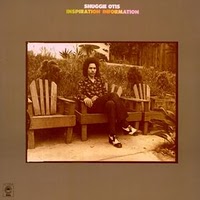 This is the ultimate soul-chill album. Shuggie is extremely versatile and this album exploits that ability. He might take you through a blaxploitation-era-sounding L.A. street walk as in the opener and “Strawberry 23”, a dub-influenced Hammond organ tune in “Aht uh Mi Head”. “Happy House” almost sounds like a millennial drum and bass piece. “Sweet Thang” might be one of the best soul jams on a blues number I’ve ever heard (here he’s successfully aped Duane Allman on guitar). He tries for some experimental stuff on his beat machine but the songs that shine are when he allows his guitar to create the atmosphere. Shuggie’s excellence is extremely subtle due in part to his highly laxed and soft vocal style and his tendency towards quiet groove. But this IS a 2am come down lazy groove album in the best sense. Don’t give up on the album in the middle instrumental section which drops off, as the album’s second half picks up starting with “Strawberry 23”. The high point of the album is the groove he kicks on the second half of “Island Letter”. All this, and the fact that Otis was practically a toddler when he made Inspiration Information, set the tone for what is certainly one of the most underappreciated albums and artists of all time. –B
This is the ultimate soul-chill album. Shuggie is extremely versatile and this album exploits that ability. He might take you through a blaxploitation-era-sounding L.A. street walk as in the opener and “Strawberry 23”, a dub-influenced Hammond organ tune in “Aht uh Mi Head”. “Happy House” almost sounds like a millennial drum and bass piece. “Sweet Thang” might be one of the best soul jams on a blues number I’ve ever heard (here he’s successfully aped Duane Allman on guitar). He tries for some experimental stuff on his beat machine but the songs that shine are when he allows his guitar to create the atmosphere. Shuggie’s excellence is extremely subtle due in part to his highly laxed and soft vocal style and his tendency towards quiet groove. But this IS a 2am come down lazy groove album in the best sense. Don’t give up on the album in the middle instrumental section which drops off, as the album’s second half picks up starting with “Strawberry 23”. The high point of the album is the groove he kicks on the second half of “Island Letter”. All this, and the fact that Otis was practically a toddler when he made Inspiration Information, set the tone for what is certainly one of the most underappreciated albums and artists of all time. –B
Siouxsie and the Banshees “Kaleidoscope” (1980)
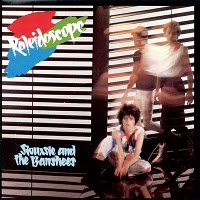 And so the Banshees effectively start over, with a new drummer (Budgie), new guitarist (John McGeoch), and a new sound. They keep the heart of darkness that was at the core of The Scream, but swap the constant jittery guitar and fractured beat for something sleeker, stranger, more expansive and greater. Put it this way: if the first two albums were grainy black-and-white, Kaleidoscope is a big-screen epic in glorious technicolor. The band absorbs elements that would have seen out of place just a year earlier: the acoustic guitars of “Christine”, the keyboards of “Happy House”, the swirling psychedelic feel to much of the record. Yet the Banshee’s signature sounds — Siouxsie’s emphatic vocals and Steven Severin’s flowing bass — are at the core of the album. A triumph, yet they would make even greater records down the track. –Brad
And so the Banshees effectively start over, with a new drummer (Budgie), new guitarist (John McGeoch), and a new sound. They keep the heart of darkness that was at the core of The Scream, but swap the constant jittery guitar and fractured beat for something sleeker, stranger, more expansive and greater. Put it this way: if the first two albums were grainy black-and-white, Kaleidoscope is a big-screen epic in glorious technicolor. The band absorbs elements that would have seen out of place just a year earlier: the acoustic guitars of “Christine”, the keyboards of “Happy House”, the swirling psychedelic feel to much of the record. Yet the Banshee’s signature sounds — Siouxsie’s emphatic vocals and Steven Severin’s flowing bass — are at the core of the album. A triumph, yet they would make even greater records down the track. –Brad


